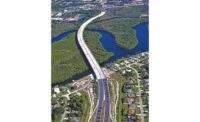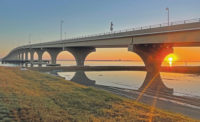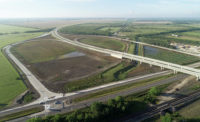Crosstown Parkway Extension Design-Build Project | Submitted by RS&H Inc.
Port St. Lucie, Fla.
Region: ENR Southeast
Owner City of Port St. Lucie
Lead Design Firm/Structural/Civil Engineer RS&H Inc.
Contractor Archer Western Contractors LLC (Walsh Group)
Construction Engineering and Inspection Consor Engineers LLC
Crews utilized a temporary trestle and precast pile caps to mitigate challenges posed by environmental conditions and permitting issues, completing the Crosstown Parkway Extension in Port St. Lucie, Fla., two months early and $13 million under budget.
The 4,000-ft-long bridge and 1.5 miles of roadway improvements constitute a third crossing into Port St. Lucie that relieves traffic congestion and provides an additional hurricane evacuation route. The project transformed a residential street into a continuation of the Crosstown Parkway corridor, with three lanes in each direction divided by a landscaped median, bicycle lanes, meandering sidewalks and landscaped berms.
The corridor includes a “superstreet” intersection, the first of its kind in Florida. The superstreet is a restricted crossing U-turn intersection, designed for when traffic on the major road will be much heavier than on the cross street.
The bridge, composed of Florida I-beams and a cast-in-place deck, traverses a highly environmentally sensitive area, including the Savannas Preserve State Park. The bridge sits on over 300 prestressed concrete piles with a maximum pile length of 85 ft, says Rachel Back, business development and strategy specialist with RS&H, the lead design firm for the design-build team.
The team designed the bridge with geotechnical information obtained from the channels and geotechnical knowledge from completing a similar bridge 11 miles away. The borings were obtained from the temporary construction trestle under the overall project permit, eliminating need for a separate permit. Archer-Western had done similar work on a bridge in Daytona Beach, says Brian Sparks, the contractor’s design-build manager.
The project required restricted construction hours due to neighbors and US Highway 1. Two hurricanes affected the area during construction, requiring securing and clearing before construction could begin again.






Post a comment to this article
Report Abusive Comment